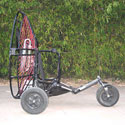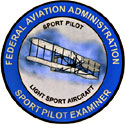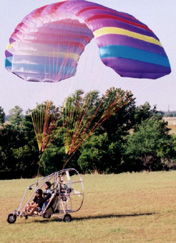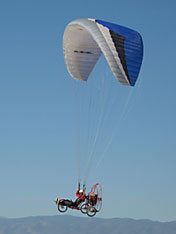|
PPC vs PPG Trike - A Comparison
Powered Parachute
|
Powered Paraglider Trike
|
What is it? |
|
| A Powered Parachute (PPC) is a flexible winged, ultralight recreational vehicle (see description below). A PPC combines a three wheeled cart structure, holding pilot and motor with a parachute type wing similar to those used by parachutists. The wing itself is made of Nylon fabric with suspension lines usually made of Spectra or Kevlar. The thrust from the engine pushes the cart forward and forces air into the leading edge of the wing, causing it to "inflate" and pressurize, thereby keeping the shape designed to fly as an airfoil. | A Powered Paraglider (PPG) Trike is also a flexible winged, ultralight vehicle used for recreational purposes. A PPG Trike combines a three or four wheeled cart structure that holds pilot and motor with a paraglider. While similar to a PPC wing, the Paraglider wing is a higher performance airfoil which can be used for foot launched free flight, and is capable of soaring flight in thermals or ridge lift. Like a PPC, the PPG Trike inflates the wing with the thrust from the motor, and is maintained in the airfoil shape by the movement forward by the Trike. |
How big is it? |
|
| A PPC is quite large and heavy, certainly more than what is needed for one person to fly solo. The motor is often a Rotax or similar, with 400cc (around 40 hp.) or more of power, up to over 900cc (80-100 hp.). The motor alone often weighs several hundred pounds. They are around six feet wide and ten feet long. Canopies are from 400 to over 500 square feet in area, depending on payload (solo or tandem). | PPG Trikes are small and light, quite often under 100 lbs. The motor is often fitted to the weight of the person flying the unit, and can be as little as 100cc in size, around 18 hp. More often, they are between 170cc and 325cc in size, somewhere between 25 and 35 hp. The motor can also be foot launched by the pilot, giving it extra versatility. The size of the trike can vary from less than four feet wide and five feet long to six feet wide and around the same length. Paraglider canopies range from under 200 square feet for solo flight to just under 400 for tandem use. |
How do I transport it? |
|
| Most PPC's weigh many hundreds of pounds, making it necessary to trailer or truck the unit to the runway. Moving the aircraft around is relatively easy, since there are three wheels to roll it easily along the ground. Ramps are needed to get the vehicle onto a trailer, and often another person is needed as well to push it up onto a trailer. |  PPG Trikes are easily dismantled and folded for transport. The PPG motor often fits into a large suitcase or equivelent, and the trike is often folded or disassembled to fit into most car's trunks. Paraglider wings fit into a mid size backpack. PPG Trikes are easily dismantled and folded for transport. The PPG motor often fits into a large suitcase or equivelent, and the trike is often folded or disassembled to fit into most car's trunks. Paraglider wings fit into a mid size backpack. |
Where can I fly? |
|
| PPC's need a bit of a runway to roll out into flight. While they often operate at the same fields that PPG Trikes do, many times they will need a larger space for launch and landing. Both PPC's and PPG Trikes can be flown | PPG Trikes are small enough to launch on a very short runway. Quite often, roads, beaches, fields and dry lakes are used to achieve flight. A PPG Trike is small and light enough to "wheelbarrow" through walkways to a launch site. |
How fast does it fly? |
|
| PPC's fly at a relatively constant rate of speed all the time, due to the fixed forward glide speed of the airfoil design. Full throttle, half throttle and engine off have little effect on the forward speed, only on whether the craft is ascending or descending. PPC's fly at speeds of somewhere between 26 and 35 mph. | PPG Trikes are similar - to climb, simply add throttle; level flight is about 2/3 throttle; idle or engine off to descend back to the ground. Airspeed of a PPG Trike is somewhat slower that that of a PPC, around 20 - 25 mph, but with trimmers, higher speeds can be attained. |
How much wind can I fly in? |
|
| It is not recommended to fly PPC's in wind conditions exceeding 12-15 mph. Since this aircraft is heavier, it can be flown in slightly higher winds than a PPG Trike. Most PPC and PPG Trike pilots prefer to fly in the morning, late afternoon and into the evening when the wind conditions are smooth and calm. | As a beginner, we do not recommend flying in winds of more than 5-8 mph. Once a pilot has more experience, they may choose to fly in higher wind conditions, although the inherent beauty of this type of aircraft is being able to launch and land in calm conditions with minimal effort. Windy conditions can cause either a PPC pr PPG Trike to "turtle" onto its back, or simply be unpleasant and unsafe, due to turbulence. |
What happens if the engine quits? |
|
| No need to worry! In the unlikely event of an engine out, the pilot simply parachutes back to Mother Earth. Since a PPC is quite heavy, the landing can be quite hard, since there is limited ability to "flare" for a landing and the glide slope is quite steep. It is always recommended to keep a useable landing zone within glide at all times in both PPC's and PPG Trikes. | With a PPG Trike, if your motor ever quits, you glide back down to land just like a paraglider - with a good flare to round out the landing, setting the craft down gently. Because the PPG Trike uses a regular paraglider, the glide slope is significantly better than a PPC. Paragliders also fly slower than PPC's and use brake toggles in your hands, so executing a good flare to land softly is quite easy. |
How long can I fly on a tank of gas? |
|
| PPC's with 10 gallon fuel capacity can fly for up to 3 hours. Smaller PPC's with 5 gallons or less can fly for up to 2 hours. Due to the larger motor required to fly Powered Parachutes, the fuel consumption is considerably higher than a PPG Trike, around 3 gal/hr. | PPG Trikes vary widely in their manufacture. Some get only two hours of flight time before needing to be refueled, while others sip gas at a lower rate and/or have a larger tank that holds more fuel. Since the engine is so much smaller than a PPC, the fuel consumption is much less overall. Three to four hours of flight time is possible on many PPG motors, although your bladder may not be able to keep up! |
How much training do I need? |
|
| PPC dealers often state that you can learn to fly in 2-3 days. While this is true, this is quite often not enough supervised training to produce a safe pilot for the long term. There are many factors that are in play when we fly, we can't simply pull the plane over to the side of the road like we can our car! Quite often, the cost of training will be less than the propellers and parts broken by minimally or self trained pilots! | PPG Trikes use modern paragliders for their airfoil. Many factors must be considered and skills need to be mastered before we can be considered pilots. Our first solo flights are often made during the first weekend of training, but for certification we will need a minimum of five flying days under supervision. Remember, this is for your benefit! Competent, safe pilots fly for years - the rest of their lives, not just the rest of the week. |
Do I need a license? |
|
 For most Powered Parachutes, you will soon need a Sport Pilot License, since most PPC's weigh more than 254 lbs and carry more than 5 gallons of fuel. PPC's will also need for you to register, N-number and obtain an Airworthiness Certificate for Special Light-Sport Aircraft. There are some 103 legal PPC's now available that are under 254 lbs and carry only 5 gallons of fuel, allowing them to operate under FAR Part 103 (see below). For most Powered Parachutes, you will soon need a Sport Pilot License, since most PPC's weigh more than 254 lbs and carry more than 5 gallons of fuel. PPC's will also need for you to register, N-number and obtain an Airworthiness Certificate for Special Light-Sport Aircraft. There are some 103 legal PPC's now available that are under 254 lbs and carry only 5 gallons of fuel, allowing them to operate under FAR Part 103 (see below). |
Powered Paraglider Trikes, like foot launched PPG's, are still considered Ultralight Vehicles, and do not require a license to fly. PPG Trikes also do not require registration with the FAA, N-numbers or Airworthiness Certificates. Most flying sites, however, require pilot certification to make sure there has been adequate training for the pilot to fly safely. Respect the pilot community and their desire to keep flying where they do - Get certified instruction! |
| I got my first two videos up on youtube.com if you want to take a look.
We went up to Hank Strong's for his annual fly-in. These came from flights 3 and 4 in the Para-Ski. This one is the long one, 9 min http://www.youtube.com/watch?v=j3fbyxe4O08 this is a shorter version of the same footage, 4 min http://www.youtube.com/watch?v=yMujZ-4YZkU they both start with the same song and the longer one has an other song and more video on it. So I learned a bit in the making of these vids It was fun taking these and then spend the time to learn more about how to put it all together. hope you enjoy and will give me your thoughts. BTW Ken and I went out to Athens tonight, I was not sure about the flying because of the wind direction, he took off just fine and after a bit I decided to give it a go. I am amazed at the climb rate of these PPC's, not the same in a PPG that's for sure. The more I fly mine the better I feel about it. I got flight # 5 and 25 minutes tonight. Mark
Mark, Nice camera and editing work. Glad to see you're enjoying your ppc. Do you miss your buggy trike at all or is the Paraski the flying carpet for you. Now that you've flown both ppg trike and ppc quad, can you share any insight as to the pros and cons. Cheers Jerry
Jerry, Thanks Man. I think my first love will always be the trikebuggy. It was such a dream to launch and land, was the coolest one going in my books. That being said I am rapidly being fully converted to PPC flying for several reasons Gotta like the power and climb rate and steering with your feet. The launch is very straight forward with this machine, basically, good layout, get to full power, make sure all is well and hang on cause you are going to go up fast. The PPC wing reacts to not enough power just like a PPG wing does, in that it will fall to the side if you do not control it by "force" aka power. I like the speed, not much more than PPG, cruse @ 30 MPH but you can cover a lot more ground in a shorter time. I feel that it won't be long till I am comfortable flying 15 feet or so off the deck. What I do find is the lag time in reaction to inputs compared to a PPG wing, even my Power Atlas which is a tank. I have watched several PPC pilots put their machines through the paces and they are doing fine with the PPC wings. Having the power to climb and the stability of the wing reassures me up there. I had not gotten to the point that I was comfortable with the stability of the PPG wing. I know it re inflates quickly, I just do not like how a tip will collapse. I have 5 flights and 3hr 45 minutes so far on the Para-ski and my shoulder have not bothered me at all, in 15 minutes of PPG flying I was getting stiff and aching shoulder joints. But when you steer with your feet that is what you get. Sitting up higher in the para-ski is not as bad as I thought it would be compared to how low I sat in the trikebuggy set up. I still like the very low seating of the TB but am ok with the PS. The other night I took off @ athens field, was not sure just how much room I would need till I got in the air and how well I would climb to clear the power lines. Kenny told more several times that I would have no problems at all. He was right. That thing scooted across the field and before you knew it I was climbing like crazy. Even the turbulent air is easier to handle in the PPC and I do not like turbulent air. One of the guys flying a PPG trike said at one point he was not penetrating to make it back to the field, well he did make it. I did not have a problem at all with the head wind we had. Lets see what else, I can do things with my hands while I am flying, like running a camera. I did not feel comfortable taking my hands off the controls because I was told over and over to keep them up there to be ready just in case you take a collapse. Don't get me wrong PPG's are a hell of a lot of fun to fly, it is just that the PPC is more suited to my over all enjoyment. I still have my wing and free flight harness and will get some PG airtime I am sure. Mark. |



